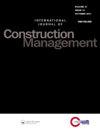Structural parameters of Wrench – C shape building using CFD
IF 3.4
Q2 CONSTRUCTION & BUILDING TECHNOLOGY
International Journal of Construction Management
Pub Date : 2023-10-24
DOI:10.1080/15623599.2023.2271218
引用次数: 0
Abstract
AbstractWind flow pattern and generation of strong and large eddies is mainly responsible to the wind pressure and suction intensity in and around the tall building. If the shape of the structure is not vary common then the wind generated effects need to evaluate for the high rise structure this is because of the reason that the data for the regular plan cross sectional shape is available in the various international standards. This study investigating the wind effects on irregular cross sectional shape tall building using CFD tool ANSYS CFX. The current study evaluates the wind impacts for a boundary layer atmospheric wind flow from 0° to 180° at a 15° interval. The power law described in IS: 875 (Part 3): 2015 for terrain category II follows the wind profile. For a rectangular model, the values of the pressure coefficients are compared using the numerical simulation and the information supplied in IS 875. Results are given at numerous locations, including pressure coefficients around the building model’s periphery and force and moment coefficients for wind incidence angles ranging from 0° to 180° at 15° intervals.Keywords: Irregular modelC shape modeltall buildingCFDpressure around the buildingforce and moment coefficients Disclosure statementNo potential conflict of interest was reported by the authors.Additional informationFundingThis work was funded by Delhi Technological University.基于CFD的扳手- C型建筑结构参数分析
[摘要]高层建筑内部及周围的风压和吸力强度主要取决于风的流型和大涡流的产生。如果结构的形状不常见,那么需要对高层结构进行风产生的影响进行评估,这是因为各种国际标准中都有规则平面截面形状的数据。利用CFD工具ANSYS CFX,研究了风对不规则截面形状高层建筑的影响。本研究以15°为间隔,对0°~ 180°的边界层大气风流进行了风的影响评价。IS: 875 (Part 3): 2015中描述的II类地形的幂律遵循风廓线。对于矩形模型,使用数值模拟和IS 875提供的信息对压力系数值进行了比较。给出了许多位置的结果,包括建筑模型周边的压力系数,以及以15°间隔从0°到180°的风入射角的力和力矩系数。关键词:不规则模型c型模型高层建筑cfd建筑周围压力力和弯矩系数披露声明作者未报告潜在利益冲突。本研究由德里理工大学资助。
本文章由计算机程序翻译,如有差异,请以英文原文为准。
求助全文
约1分钟内获得全文
求助全文
来源期刊

International Journal of Construction Management
MANAGEMENT-
CiteScore
8.60
自引率
17.90%
发文量
112
期刊介绍:
The International Journal of Construction Management publishes quality papers aiming to advance the knowledge of construction management. The Journal is devoted to the publication of original research including, but not limited to the following: Sustainable Construction (Green building; Carbon emission; Waste management; Energy saving) Construction life cycle management Construction informatics (Building information modelling; Information communication technology; Virtual design and construction) Smart construction (Robotics; Artificial intelligence; 3D printing) Big data for construction Legal issues in construction Public policies for construction Building and Infrastructures Health, safety and well-being in construction Risk management in construction Disaster management and resilience Construction procurement Construction management education
 求助内容:
求助内容: 应助结果提醒方式:
应助结果提醒方式:


